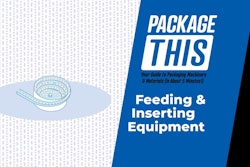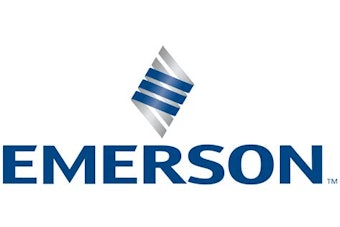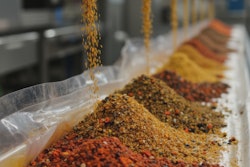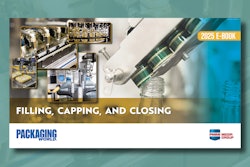Since the 1930s, Chelsea Milling of Chelsea, MI, has been producing Jiffy® mixes for home baking of muffins, biscuits, brownies, cakes and other delectables. The popular mixes are sold in just two carton sizes, approximately 40 oz and about 8.5 oz. (Weights vary slightly among the 19 different SKUs due to density differences.)
About 1.4 million of the small cartons pour out of the plant each day. Considering that each carton must be glued on the bottom, side and top, and that 24-count corrugated trays and shippers must also be glued, the Chelsea plant is a big adhesives consumer. But thanks to an "adhesives volume reduction" program implemented a few years ago with assistance from supplier National Starch & Chemical (Bridgewater, NJ), Chelsea uses no more than it needs.
"It's partly a matter of looking at some of the little things we were doing with our equipment that we shouldn't have been," says maintenance department leader Chuck Elkins. "Take air pressure, for example. You can put down twice as much glue as you're supposed to if the air pressure in the applicator is out of adjustment. It doesn't sound like a whole lot when you're talking about a little dot of glue, but when you go through more than a million cartons a day like we do, it really adds up."
Another important component in the adhesives reduction plan is an aggressive approach to maintenance. Adhesive melt tanks, glue pots, supply lines and nozzles are cleaned frequently.
"There's a strong commitment to keeping the machines clean to ensure that they run as well as possible," says National Starch sales supervisor Rob Bennett. "The better they keep their machines, the higher the productivity."
Both cold and hot melt adhesives are used at Chelsea. The newest in the mix is National Starch's Cool-Lok(TM) 34-2110. It's used to seal carton tops as well as corrugated trays and cases. Unlike Instant-Lok® 34-2710, which requires heating to 350°F, Cool-Lok operates at 250°F. That yields significant energy cost savings. The material is also less prone to charring in the equipment, so clean-up and maintenance is simpler.
But what impresses Elkins most about Cool-Lok is the added safety factor it brings. "Prevention of burns is a big priority with me," he adds. "We haven't had any burns in a while."
Pound for pound, the Cool-Lok costs a little more than other hot melts, says Elkins. But he says the adhesive is still a good value because the amount required to get a strong bond is small. "Altogether, we have some thirty hot melt units in the plant," he adds. "We use the Cool-Lok wherever we can." All the hot melt systems are supplied by Nordson (Duluth, GA).
Where Cool-Lok can't be used is on older hot melt units designed to operate at temperatures of 280°F and higher. At these temperatures Cool-Lok would have the wrong viscosity. "It would squirt out of the nozzle like water," says Elkins. So for these units, some mounted on carton top-sealers and some on case sealers, Chelsea relies on Instant-Lok® 34-2710 instead.
Cold glue on DPMs
The cold glue used at Chelsea, National Starch's Resyn® 33-9088, is used exclusively on all 18 of Chelsea's DPM (double-package-making) machines. In operation now for many years, these machines take roll-fed waxed paper and form it around a mandrel. Then an unglued carton blank is wrapped around the paper-covered mandrel, and cold glue is applied to the carton side and bottom.
Cartons are 17-pt clay-coated newsback, printed offset in five colors by a division of Chelsea Milling called C&S Cartons in Marshall, MI. The mandrel is heated to activate the glue and both side and bottom flaps are mechanically compressed to form a finished carton. Exiting the DPM machine, each carton is ready to be filled.
Carton-filling and top-sealing equipment is anything but brand new, as Chelsea's custom when it comes to packaging lines is to refurbish rather than replace. But all of the equipment is lovingly maintained. The company's skilled mechanics have their own machine shop and make new parts rather than simply replacing an entire machine or processing line when parts wear. So the equipment operates at the tightest tolerances, even if it isn't brand new, says Elkins.
New tray packing
Equipment at Chelsea that is new, however, usually involves secondary packaging. A VERSATech(TM) LS 800 DL dual-infeed shrink bundler and a MULTITech(TM) 2000 tray maker/packer are good examples. Both were supplied by Automation Packaging Inc. (Tampa, FL).
"Our marketing people wanted to try a six-pack arrangement for promotional sales of corn muffin mix, our biggest seller," explains Elkins. "With this equipment, we can shrink-wrap six cartons in film and then put four of the six-packs into a tray."
According to director of operations Jack Kennedy, single responsibility for both the bundler and the tray maker/packer was an important consideration. "You don't want two independent suppliers pointing fingers at each other if something goes wrong," he observes.
Flexibility was also a key. According to Kennedy, some Chelsea customers like the idea of an open 24-count display tray, but they don't want the individual cartons bundled in shrink film.
"API came up with an infeed configuration that lets us bypass the bundler if we need to," says Kennedy. "The cartons are then collated and tray-packed as individual units. That was one of API's strengths in this project. They looked at our needs and then designed a system around those needs. They also managed to keep the system's footprint small, another key objective we had."
The API shrink bundling system has a pick-and-place assembly that places a piece of chipboard on the shrink film. The six cartons go on top of the chipboard. On the chipboard is printed a UPC code that shows through the shrink film so that the supermarket checkout scanners ring the correct six-pack price when the bundle is scanned.
Also incorporated into the API system is a Patrion ink-jet coding system from Marsh (Belleville, IL). It prints date and time on the side of the corrugated tray.
Four cartoning lines can feed into the API system. All are dedicated to Chelsea's corn muffin mix in the smaller carton. Cartons are tray-packed at about 180/min. Corrugated display trays, from Green Bay Packaging (Green Bay, WI), are 150#-test, B-flute. Shrink bundling film used by Chelsea is from Cryovac (Duncan, SC), which describes it only as a "multilayered cross-linked polyolefin."
In-plant ink-jet printing
Even more recently installed at Chelsea, with help from an equipment distributor called Ship-Pack (Kalamazoo, MI), is an ink-jet case printing system. Cases from Green Bay Packaging are printed by Chelsea's C&S division, which can convert them more cost effectively than an outside vendor, says Kennedy. For high-volume corn muffins, shippers are preprinted by C&S with everything but variable information such as date and lot codes. That information is printed on-line by ink-jet coders.
But Chelsea has 18 other SKUs that represent smaller unit volumes than corn muffins. To keep from having to inventory pre-printed cases for these products, the firm used to order a generic case printed only with the company and brand name and other non-variable information. A total of nine rotary drum printers with rubber ink pads, each printer dedicated to one packaging line, printed the variable information at the Chelsea plant.
But last summer that changed. In place of the nine drum printers, Chelsea now has two ink-jet stations that print variable information such as product name, case weight, production date and bar code. Each station consists of a Model 2512 vertical case transport system from Kiwi Coders (Wheeling, IL) and four ink-jet print heads from Marsh. The Kiwi unit picks one knocked-down blank at a time and puts it in a set of belts that, with help from guiderails, drive the blank past the print heads.
Two different models of print heads are employed at each print station. On one side are two Model AN-256 print heads and one 96-dot print head. The AN-256 units print product identification, date, time and a 100% scannable bar code. The 96-dot print head repeats product identification and takes care of case count. On the opposite side is mounted a single 96-dot print head for product identification and case count.
Each Marsh printer is governed by an Overture® LT controller that's programmed to print cases in groups of eight. So, for instance, as soon as eight blueberry cases are done, the system automatically begins to print the next flavor. The operator takes the eight blueberry cases to the nearby case packer. When he's finished packing those eight cases, eight new ones with the new flavor are freshly printed and waiting for him.
One operator does it all
A single operator is responsible for case printing and case packing. The operator takes a printed case by hand, prefolds the bottom, and places the case on the horn of a semi-automatic case packer. Collated cartons are loaded and the case is conveyed off to hot melt sealing.
Five different packaging lines feed the case packer in Room A and four lines feed the packer in Room B. Case packing is the same in both rooms. For example, near the end of each packaging line in Room A, and just ahead of the case-packing area, are five long accumulation lanes filled with cartons. These lanes all empty into the same conveyor, which in turn leads to the semi-automatic case packer.
The accumulation lanes are governed by a PLC that directs the lanes to take turns releasing cartons to the case packing station. In Room A, for instance, Lines 4 and 5 hold cartons back until eight cases worth of cartons from Line 1 have been case-packed. Then a stop halts Line 1 cartons' forward progress, and Line 2 releases its cartons toward the case packer. The sequence continues until Line 5 releases its cartons, and then the cycle repeats itself.
One of the chief benefits of the new case-printing system, says Kennedy, is that now bar codes can be incorporated onto all cases. "Customers want bar codes," says Kennedy. Had Chelsea tried to include them via their drum printers, the code wouldn't have been consistently scannable, says Kennedy.
Other advantages Chelsea enjoys since the addition of the Kiwi/Marsh systems are print crispness and greatly simplified maintenance and changeover.
"With the drum printers, we had to remove a drum to change to a new product," says Kennedy. "Now we just go to the computer and type in a new product code."
Now running successfully at Chelsea for about nine months, the case coding system is a big hit. "I wonder why more people don't do it this way," says Kennedy.





























